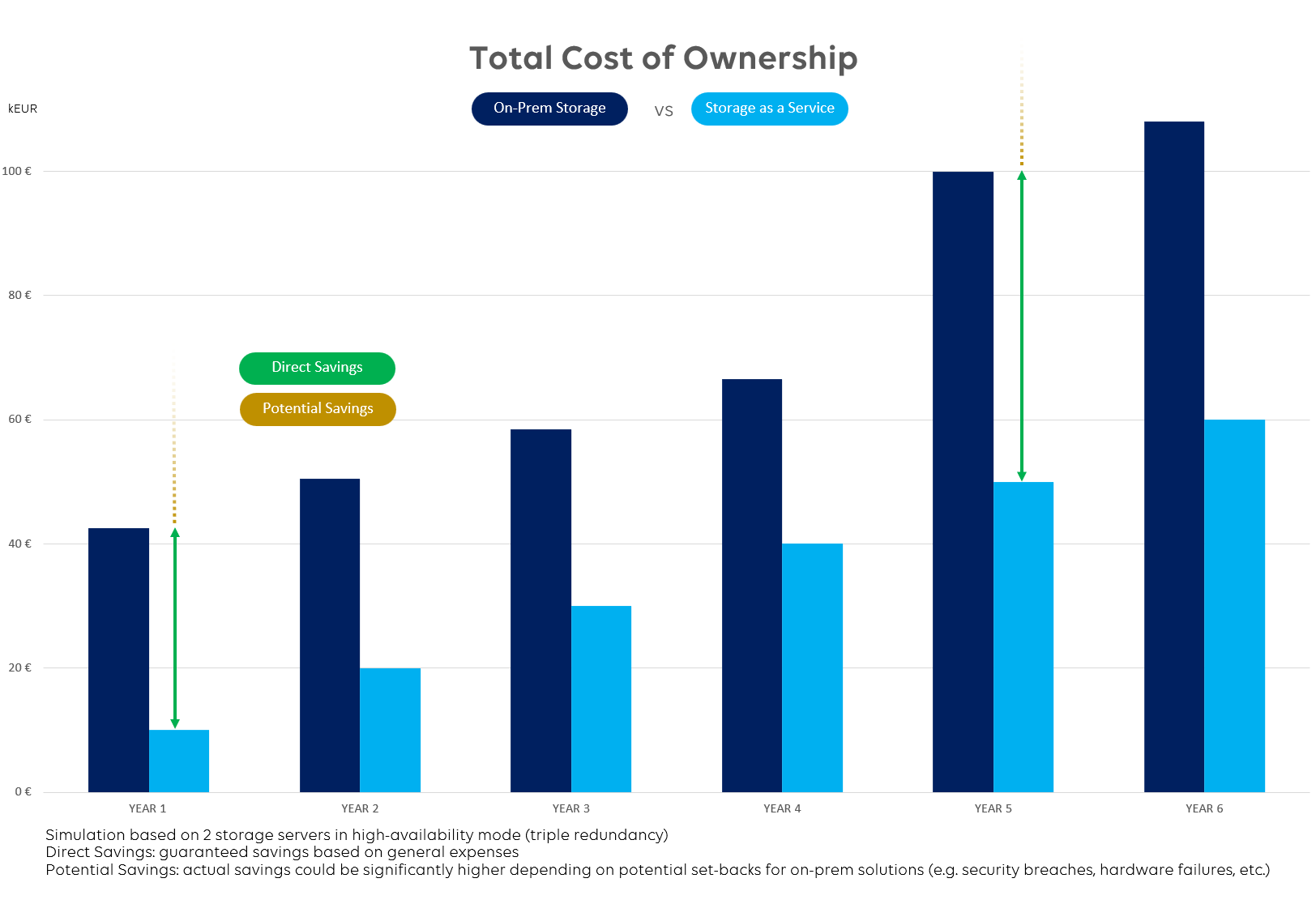As businesses increasingly rely on efficient data management, the need for cost-effective storage solutions becomes critical. Storage as a Service (STaaS) offers an approach that not only optimizes costs but also provides tailored storage options for diverse data types. Its key advantage is shifting the responsibility and financial burden of managing data storage infrastructure and technology to a highly professional cloud provider. This allows for seamless scalability of storage resources without the need for new hardware investments and recurring configuration costs.
Efficient pricing: pay only for what you use, regardless of traffic
To calculate the return on investment (ROI) for STaaS versus on-premises storage, you need to consider at the minimum the following considerations:
- On average, every five years, you will need to replace your on-prem servers. This entails managing and bearing costs for the ordering process, configuration, installation, setup and OS licenses, firewalls, racks, routers, and switches.
- In today’s world, the environmental cost associated with power and cooling is a significant expense that cannot be overlooked. For example, a single hardware server consuming 850 W translates to 7,446 kWh/year, resulting in an annual energy bill of 1,489 EUR per server, calculated at an average cost of 0.20 EUR/kWh.
- If you want to keep your data safe, you cannot afford to neglect security and cybersecurity. This aspect demands significant time and financial commitment. Companies like Microsoft have over 3500 globally distributed cybersecurity experts who address vulnerabilities before they even become known. However, many organizations struggle to match this pace, leading to substantial investments without ensuring comprehensive security measures.
- Downtime can result in significant financial implications. On average, depending on the situation, a server outage could lead to a corporate cost of up to $5,600 per minute. Professional studies reveal that 43% of SMBs shut their doors following a severe blackout.
- The costs associated with staffing and operations to maintain databases, including necessary upgrades, patch deployments, testing, etc., can amount to thousands of euros annually per IT professional, even if the individual only dedicates 3% of their time to these tasks.
- On-prem servers depreciate over time, whereas cloud service expenses are considered operating expenses that can be deducted as costs. Your accountant and tax entities will welcome the shift to opex!
- Achieve a pay-for-what-you-need model with STaaS. This allows you to effectively adjust (increase or decrease) your storage needs in real time, as opposed to purchasing a full estimated storage capacity on day one, which might not even be utilized initially.
DataMiner STaaS is fully hosted within the highly secure and triple redundant Azure Cloud Cosmos DB and Azure Table Storage environments, ensuring high availability, global distribution, and turnkey capabilities. With global coverage, your data is stored in your specific region, complying with national security and data accessibility regulations. To existing DataMiner customers, we now offer a complementary auto live data migration process, activated with just a few clicks.
Depending on the data nature and chosen storage strategy, DataMiner STaaS calculations indicate potential cost saving of up to 43% over a 5-year period compared to on-premises storage computing. Given the volatile nature of upfront and annual operational costs, StaaS is undeniably a game-changer indeed.

For more information, please reach out to your sales representative.
Very nice article, beautiful!
Clearly explained Skyline’s STaaS advantages over self-hosted storage, from both financially & infrastructure administration perspectives.
DataMiner STaaS saves money & time = VALUE!
Awesome!
Great article to share